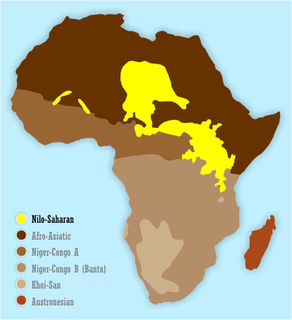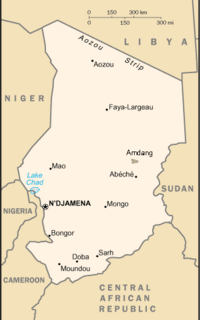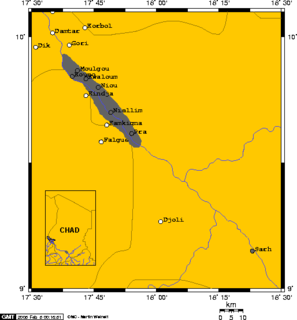
Persian, also known by its endonym Farsi, is one of the Western Iranian languages within the Indo-Iranian branch of the Indo-European language family. It is a pluricentric language primarily spoken in Iran, Afghanistan and Tajikistan, Uzbekistan and some other regions which historically were Persianate societies and considered part of Greater Iran. It is written right to left in the Persian alphabet, a modified variant of the Arabic script.

The Nilo-Saharan languages are a proposed family of African languages spoken by some 50–60 million people, mainly in the upper parts of the Chari and Nile rivers, including historic Nubia, north of where the two tributaries of the Nile meet. The languages extend through 17 nations in the northern half of Africa: from Algeria to Benin in the west; from Libya to the Democratic Republic of the Congo in the centre; and from Egypt to Tanzania in the east.

The Tswana language or Setswana is spoken in Southern Africa by about five million people. It is a Bantu language belonging to the Niger–Congo language family within the Sotho-Tswana branch of Zone S (S.30), and is closely related to the Northern and Southern Sotho languages, as well as the Kgalagadi language and the Lozi language.
Shona (chiShona) is the most widely spoken Bantu language as a first language and is native to the Shona people of Zimbabwe. The term is also used to identify people who speak one of the Central Shona varieties: Zezuru, Karanga, Manyika and, Korekore and Budya. Based on Clement Doke's 1931 report, Union Shona or Standard Shona was developed from the Central Shona varieties. Because of the presence of the capital city in the Zezuru region, that variety has come to dominate in Standard Shona. The larger group of historically related languages also includes Ndau and Karanga, but speakers of those languages prefer their distinct identities and usually reject any connection to the term Shona.
Sranan Tongo is an English-based creole language that is spoken as a lingua franca by approximately 500,000 people in Suriname.

Laal is an endangered language isolate spoken by 749 people in three villages in the Moyen-Chari prefecture of Chad on opposite banks of the Chari River, called Gori (lá), Damtar (ɓual), and Mailao. It may be a language isolate and thus would represent an isolated survival of an earlier language group of Central Africa. It is unwritten except in transcription by linguists. According to former Summer Institute of Linguistics-Chad member David Faris, it is in danger of extinction, with most people under 25 shifting to the locally more widespread Bagirmi.

Amdang is a language closely related to Fur, which together constitute a branch of the Nilo-Saharan language family. It is mainly spoken in Chad, north of the town of Biltine, and sporadically elsewhere in Ouaddaï Region. There are also small colonies of speakers in Darfur near Woda'a and Fafa, and in Kordofan in the Abu Daza district and at Magrur north of Bara. Most of the ethnic group now speaks Arabic.
The Bua languages are a subgroup of the Mbum–Day subgroup of the Savanna languages spoken by fewer than 30,000 people in southern Chad in an area stretching roughly between the Chari River and the Guera Massif. They were labeled "G13" in Joseph Greenberg's Adamawa language-family proposal. They are ultimately part of the Niger–Congo family, and have exerted a significant influence on Laal.

The Niellim language is a Bua language spoken by some 5,000 people along the Chari River in southern Chad. It is mainly spoken in two areas: one around the city of Sarh and one, its traditional home, further north, between about 9°30′ and 9°50′ N, corresponding to the former chiefdoms of Pra, Niellim, and Niou.
Fula, also known as Fulani or Fulah, is a language spoken as a set of various dialects in a continuum that stretches across some 20 countries in West and Central Africa. Along with other related languages such as Serer and Wolof, it belongs to the Senegambian branch within the Niger–Congo languages, which does not have tones, unlike most other Niger–Congo languages. More broadly, it belongs to the Atlantic geographic grouping within Niger–Congo. It is spoken as a first language by the Fula people from the Senegambia region and Guinea to Cameroon and Sudan and by related groups such as the Toucouleur people in the Senegal River Valley. It is also spoken as a second language by various peoples in the region, such as the Kirdi of northern Cameroon and northeastern Nigeria.
Haya is a Niger–Congo language spoken by the Haya people of Tanzania, in the south and southwest coast of Lake Victoria. In 1991, the population of Haya speakers was estimated at 1,200,000 people.
Kalami (کالامي), also known as Gawri (ګاوری), Garwi, or Bashkarik, is a Dardic language spoken in Swat Kohistan region in the upper Swat District and in the upper Panjkora river valley of Upper Dir District, Khyber Pakhtunkhwa, Pakistan.
Murrinh-patha, called Garama by the Jaminjung, is an Australian Aboriginal language spoken by over 2,500 people, most of whom live in Wadeye in the Northern Territory, where it is the dominant language of the community. It is spoken by the Murrinh-Patha people, as well as several other peoples whose languages are extinct or nearly so, including the Mati Ke and Marri-Djabin.

English is a West Germanic language that was first spoken in early medieval England and eventually became a global lingua franca. It is named after the Angles, one of the Germanic tribes that migrated to the area of Great Britain that later took their name, as England. Both names derive from Anglia, a peninsula in the Baltic Sea. The language is closely related to Frisian and Low Saxon, and its vocabulary has been significantly influenced by other Germanic languages, particularly Norse, and to a greater extent by Latin and French.
Murui Huitoto - is an indigenous American Huitoto language of the Witotoan family. Murui is spoken by about 1,100 Murui people along the banks of the Putumayo, Cara-Paraná and Igara-Paraná rivers in Colombia. In Peru it spoken in the North alongside the Ampiyacu and Napo rivers by some 1,000 people. Some Murui speakers live also outside their territories, for instance the vicinity of Leticia, Amazonas, Colombia.
Chadian Arabic is one of the regional colloquial varieties of Arabic and is the first language for over three million people, both town dwellers and nomadic cattle herders. The majority of its speakers live in southern Chad. Its range is an east-to-west oval in the Sahel, about 1400 miles long by 300 miles north-to-south. Nearly all of this territory is in the two countries of Chad and Sudan. It is also spoken elsewhere in the vicinity of Lake Chad in the countries of Cameroon, Nigeria, Niger. Finally, it is spoken in slivers of the Central African Republic and South Sudan. In addition, this language serves as a lingua franca in much of the region. In most of its range, it is one of several local languages and often not among the major ones.
The population of Chad has numerous ethnic groups. SIL Ethnologue reports more than 130 distinct languages spoken in Chad.
Nahuatl, known historically as Aztec, is a language or group of languages of the Uto-Aztecan language family. Varieties of Nahuatl are spoken by about 1.7 million Nahua peoples, most of whom live in central Mexico.
Maba is a Maban language spoken in Chad and Sudan. It is divided into several dialects, and serves as a local trade language. Maba is closely related to the Masalit language. It is a group of related languages spoken in the border area of Chad, the Sudan, and the Central African Republic. The Maban languages form a branch of the Nilo-Saharan language family. Maba is the largest Maban language in terms of number of speakers. Other members of the group include Karanga, Kibet, Massalat, Masalit (Massalit), Marfa, and Runga. Maban also includes two languages known by the names of their first investigators as Mimi of Nachtigal and Mimi of Gaudefroy-Demombynes, both spoken in southeastern Chad.

Maurice Gaudefroy-Demombynes was a French Arabist, a specialist in Islam and the history of religions.









